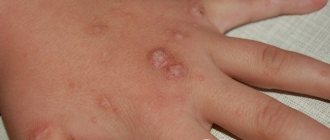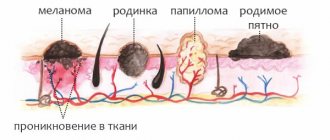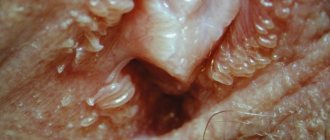A skin growth on a cylindrical pedicle, sometimes almost invisible, is called papilloma. It often appears out of nowhere and does not appear for a long time. But with any “jump” of immunity or in the heat, it suddenly appears to your eyes, first as a single person: one papilloma “mother” can “pop out” in the armpit or on the eyelid (her favorite places, for example, on the bends of the elbows and in the popliteal fossae), and then “let in” the “babies”, that is, literally “sprinkle” all sorts of places on our body. For some, this phenomenon will only be a temporary disorder - well, they say, it gets in the way, clings to clothes, and if it’s “stuck” on the face, it’s ugly, a cosmetic defect, but you don’t have to notice! But is this small growth so harmless, especially when it forms a whole colony around itself? Should I delete it, or leave it and forget it?
Is human papillomavirus (HPV) a sexually transmitted disease?
HPV
is deciphered in more detail as “a virus that causes a benign tumor of epithelial origin in the form of a papilla” - papilloma (papilloma: Latin papilla - nipple and Greek -oma - tumor). It is classified as a sexually transmitted disease (STD). The concept today has, unfortunately, become much broader, and if earlier we heard about several “terrible”, as it seemed to us, classical diseases of Venus, which are actually treated simply and are detected quickly (syphilis, gonorrhea, trichomoniasis, chancroid), then The list of “new” STDs - insidious, difficult to diagnose, and sometimes difficult to treat and completely incurable (HIV) - is constantly growing.
So, we include the following “new” STDs: chlamydia, mycoplasmosis, ureaplasmosis, gardnerellosis, genital herpes, candidiasis, and human papillomavirus. If growths from papillomavirus have formed in the areas of the genital or perianal organs, then they are called “pointed candylomas,” but in fact they are the same virus, only its different strains (types).
How to get rid of papillomas at home
At the first signs of papilloma on the skin, you can use alternative medicine methods that demonstrate sustainable positive dynamics of the disease. The warts disappear, and the human body again acquires a presentable, healthy appearance.
Productive disposal of papillomas at home is possible after preliminary consultation with your doctor; superficial self-medication is excluded:
- To stop the growth of papilloma, the best way is to rub it with dry laundry soap or celandine juice. Repeat the procedure several times until the unpleasant symptoms completely disappear.
- Prepare castor oil and rub it on papillomas all over the body. It is allowed to carry out the procedure up to three times a day. Alternatively, use garlic pulp, sour apple puree or dandelion juice for viral condyloma.
- Iodine in combination with kerosene is also effective. If you properly smear the papilloma on the palm or foot with such a medicinal composition, then after the first session it dries out, and after the second it completely disappears.
Are papilloma and condyloma the same thing?
Genital condylomas in the perineal area are sometimes single, and sometimes look like growths that resemble cauliflower in appearance. Sometimes these formations cause itching, irritation when touched, and sometimes they bleed. SM-Clinic doctors are often approached by patients who, having seen enough advertising, have been treated for years with “one pill” for supposed “exacerbations” of candidiasis (thrush). Upon examination, it turns out that the smear in such patients is normal, and the often recurring itching is actually caused by condylomas.
Why is papilloma dangerous for men?
Mostly in men, such growths appear in the form of genital warts:
- in the groin;
- the head of the penis;
- foreskin;
- bridle.
Symptoms may take a week or a year to appear. The stronger sex can be a carrier of the virus for many years, without harming its body. HPV penetrates the cell's DNA, changing it and causing epithelial growth and division. The consequences of the growth of tumors lead to a decrease in sexual activity, manifestations of impotence, and the onset of infertility.
Leads to dangerous diseases such as adenocarcinoma, anal cancer, diseases of the penis, oral cavity or larynx.
Papillomatosis in the throat
There is also papillomatosis of the respiratory tract, when the tissue lining the nasopharynx begins to grow from the nose to the lungs, also often affecting the larynx. This is also one of the types of disease caused by the papilloma virus; the formations in this case are considered benign. SM-Clinic doctors are good at diagnosing this type of HPV and successfully treating it, while the disease is not always recognized by local or ENT doctors, who at best shrug their shoulders and prescribe rinses.
Thank you for your request. Your application is accepted. Our specialist will contact you shortly
Prognosis without treatment
In addition to the indicated risk of developing cancer, there is a danger of contracting a whole range of infections attached to the injured neoplasm. This is especially true for thread-like papillomas located in areas subject to friction from clothing.
Plantar warts in children sometimes destroy themselves. But it also happens that around one neoplasm new ones are located and the lesion grows.
Thus, warts and all neoplasms provoked by the human papillomavirus are harmless and insignificant only in appearance. You can’t think for a long time about whether to remove papillomas. Their presence requires urgent contact with a dermatologist and taking adequate measures to eliminate them.
Attention!
This article is posted for informational purposes only and under no circumstances constitutes scientific material or medical advice and should not serve as a substitute for an in-person consultation with a professional physician.
For diagnostics, diagnosis and treatment, contact qualified doctors! Number of reads: 541 Date of publication: 10/23/2017
Dermatologists - search service and appointment with dermatologists in Moscow
Who is at risk of getting the papilloma virus?
Papillomas and condylomas can appear, disappear and appear again, because they are manifestations of a viral infection, and their presence depends on the state of the body’s defenses at the moment, that is, immunity. Infection is most likely among smokers and alcoholics, and among those who are indiscriminate in sexual relations.
Women using oral contraceptives for a long time
(COOK)
is also a risk factor for contracting the virus. The carrier of the virus can be both old and young. It is enough for your body to experience internal stress of various origins: you have had the flu or ARVI, gastrointestinal problems have worsened, your body cannot cope with long-term medication use - and here you have a weakened immune system, and with it the papillomavirus.
It is enough to be in close contact or live next to a person carrying the virus, take a swim in a “dirty” pool or shower in a public bath, or just walk along the beach - and if your immune system fails, the virus will invade your life. The papillomavirus “loves” heat and high humidity, when your skin is not protected by clothing. He immediately finds refuge on your heated skin.
Diagnostics
To diagnose these skin growths, you need to consult a dermatologist. Many types of skin formations clinically look similar, and only a doctor can give an accurate assessment and suggest the correct method of treatment. At the same time, it is important not only to distinguish the types of papillomas (this is necessary to determine the removal method), but also not to confuse them with a mole. The distinctive criterion is the color of the neoplasm.
Papillomas and warts are quite rarely hyperpigmented; their color generally varies from light pink to yellowish brown. However, it is only within the competence of the doctor to correctly differentiate between nevus and papilloma.
Pregnancy with papilloma virus
Infection from mother to fetus during childbirth occurs in almost 98% of cases. For a baby who passes through the birth canal, literally strewn with condylomas, the virus enters the mouth and eyes, so all women planning a pregnancy should be tested in advance and, if necessary, treated for HPV and all types of STDs. Only after completion of treatment can you plan to conceive.
If the disease was in a latent form and was first discovered during pregnancy, and this happens often (immunity weakens during pregnancy), then it is necessary to urgently consult a doctor: treatment of papilloma during pregnancy is possible.
Women at risk
Most often, women become infected with HPV, no matter how old they are. Weakened immunity, pregnancy, smoking abuse, visiting swimming pools, saunas and even beauty salons can lead to infection.
Why is papilloma dangerous for women?
- oncological diseases;
- cervical dysplasia;
- development of cervical erosion;
- the appearance of formations on the external genitalia.
The following symptoms may indicate the appearance of malignant lesions:
- Pain and pressure appear in the area of the wart.
- The color darkens and the skin becomes inflamed.
- The papilloma turns red and ichor stands out.
Are pregnancy papillomas dangerous?
HPV often becomes active while waiting for the birth of a child. Mommy is susceptible to stress and anxiety, immunity decreases, and hormonal levels change. Warts that form on the body do not pose any threat to the unborn baby. Mostly after childbirth they go away on their own.
Formations on the cervix and vagina are dangerous, as they can transmit the virus to the baby during childbirth. Although babies have a weak immune system, they most often cope with the infection themselves if it does not enter the respiratory tract. Otherwise, this will lead to the development of papillomatosis. In a child, this can cause suffocation due to respiratory diseases.
Important! In the first half of pregnancy, treatment is not prescribed to avoid fetal intoxication. If necessary, the growths are removed at an early stage or a cesarean section is performed.
We treat papilloma
Scientists have discovered more than 100 varieties of the HPV virus, but some types of genital candyloma can lead to cervical cancer, especially HPV subtypes 16, 18, 31. And the reason for this is that often, due to an asymptomatic course, a person goes nowhere for a long time appeals! Dispensary examinations have disappeared from our lives, which is why diagnosis can be quite late.
To avoid this, you need to visit an obstetrician-gynecologist twice a year, and once a year have a cytology smear (also called a Papanicolaou test or “atypia smear”) to detect precancerous changes in the cervix. It is also necessary to undergo a blood test to determine the DNA of the virus using PCR. SM-Clinic's own laboratories use high-quality reagents to more accurately determine test results. After going through them, it will become clear what types of HPV are present or absent in your body, and whether treatment is worthwhile.
- Non-oncogenic papillomaviruses - HPV 1, 2, 3, 5.
- Oncogenic papillomaviruses of low oncogenic risk - HPV 6, 11, 42, 43, 44, 54, 61, 70, 72, 81.
- Oncogenic papillomaviruses of intermediate oncogenic risk - HPV 26, 53, 66.
- Oncogenic papillomaviruses of high oncogenic risk - HPV 16, 18, 31, 33, 35, 39, 45, 51, 52, 56, 58, 59 and 68.
Do not forget that the appearance of papillomas indicates trouble in your body: these small unpleasant skin protrusions, which are easy to get rid of, signal that you have not seen a doctor for a long time, and may have developed gynecological diseases, kidney disease, gastritis or colitis.
Under no circumstances should papillomas be torn off, tied with threads, or combed out - this provokes the virus to aggressively “seize” new territories - it will simply move to an unaffected organ.
Removal without traces or complications is carried out at SM-Clinic using painless methods that do not leave marks or scars. Immunity-boosting treatment is also carried out in parallel.
Types of papillomas
- Common papillomas (vulgar warts)
- Filiform papillomas
- Flat warts
- Condylomas acuminata
- Lewandowski-Lutz papillomas
- Plantar warts Spitz (plantar wart)
- Papillomatosis
The most common form of papillomavirus.
Localization - most often the skin of the back, palms and fingers, soles and feet.
The peculiarity is the rapid appearance at the site of skin damage, due to a decrease in local immunity. The causes are infection (bacterial or fungal), skin trauma, excessive sweating, contact with household chemicals. Appearance: a papillary formation on the skin, the head is soft to the touch and has a uniform structure. The color of a vulgar wart does not differ from the color of the skin. The root goes deep under the skin, which ensures its nutrition from the blood vessels and causes the formation to increase over time.
They got their name because of the thin stalk on which the head of the papilloma rises.
Localization - places with thin skin (eyelids, neck, axillary and groin areas).
A peculiarity is that filamentous papillomas become elongated as a result of growth and appear more often in older people.
Appearance - the head of the papilloma is most often colored pink or yellowish.
This form of neoplasm consists of small flat plaques that rise above the surface of the skin.
Localization - skin of the face, hands, anus, labia in women and scrotum in men.
Feature - often accompanied by itching, resulting in an increased reaction from the epidermis and the risk of infection of the resulting wound.
Appearance - this type of papillomas has a dense structure, the root goes deep into the skin, as a result of which it has an abundant blood supply, which promotes rapid growth.
Localization - skin of the groin area and mucous membranes.
Feature - they often become inflamed as a result of injury to growths located on the skin of the labia minora or in the vagina. In addition, there is a high risk of relapse after removal of condylomas and antiviral therapy.
Appearance - a single growth forms, which grows over time on the skin and is shaped like a cauliflower or a rooster's comb.
A rare type of papillomas.
Localization - most often on the skin of the face, hands and feet.
Feature - these neoplasms have a variety of colors from light pink to brown and uneven edges, and are also dangerous and in some patients degenerate into malignant neoplasms over time.
Localization - the name speaks for itself, and therefore they are the most common type of papillomas on the skin of the feet.
Peculiarities: childhood and adolescence. The causes are a decrease in local immunity as a result of trauma to the soles, excessive sweating, wearing tight shoes and poor personal hygiene.
Appearance - there is a small rough spot on the surface of the feet, however, the growth of this type of papillomas is different in that it grows deeper. Compression and irritation of pain receptors located nearby healthy tissues occurs. As a result, there is discomfort when walking.
The most dangerous cutaneous form of human papillomavirus. It differs in that a huge number of neoplasms appear on human skin. Papillomatosis of the mucous membranes and internal organs is life-threatening.
Ways the virus enters the body and precautions
Since papillomas are dangerous, you need to know how the virus can enter the human body. HPV settles in small skin cracks, wounds, abrasions and scratches. But it only reaches a healthy person from a sick person.
The most common method of infection is considered to be any form of sex (vaginal, anal, oral). It is in this way that oncogenic strains can be obtained. Moreover, growths can appear on the external and internal genital organs, on the skin around the anus, on the hands and even in the oral cavity.
But besides this, the virus is transmitted:
- To the child, during the passage of the birth canal, from the mother.
- Through general hygiene items (washcloths, towels, razors, scissors).
- In a bathhouse, sauna, or swimming pool, there is also a possibility of infection.
But don't panic. You just need to adhere to the rules of personal hygiene and not have sexual contact with the first partner you meet. Another precaution is vaccination. Teenagers receive three vaccinations, which create lasting immunity to oncogenic HPV.
But such a procedure must be done even before a person begins to be sexually active. Otherwise, the infection has already occurred, and the vaccine will not have the desired effect.
Another danger of the virus is that immediately after infection, papillomas may not appear on the body. For a very long time, it remains dormant in the human body, since the immune system suppresses it. And when the protective functions decrease, the first growths appear.
Reasons for decreased immunity may include:
- Frequent viral diseases.
- Long-term use of medications.
- Wrong lifestyle.
- Monotonous food.
- Chronic gastrointestinal diseases.
- Frequent nervous breakdowns and stressful situations.
- Bad habits.
What to do with formations
If papillomas themselves are not as dangerous as their damage, then is it possible to remove them? Doctors believe that it is not only possible, but also necessary. The main thing is to choose the right method for removing formations. If patients still ask the question, is it dangerous to remove papillomas? Experts answer unequivocally: it is better to remove the tumor in time than to treat cancer later.
Modern civilized methods of removal make it possible to quickly and almost painlessly remove the external manifestation of the disease. But folk remedies and advice are quite harmful. Most often, traditional medicine removes papillomas using aggressive substances (acids, alkalis), which not only may not give the desired effect, but also provoke degeneration.
Clinics and beauty salons offer the following procedures for removal:
- Laser.
- A liquid nitrogen.
- Radio wave removal.
- Electrocoagulation.
- Conventional excision with a scalpel is very rarely used.
The danger of removing papilloma using such methods is that in some cases small scars remain. For any other complications, performing the procedures is absolutely not dangerous. The same cannot be said about traditional medicine. Although some say that the recipes are effective.
In addition to the fact that doctors recommend removing growths, they also suggest taking a course of drug treatment. It will consist of taking antiviral and immunostimulating drugs. Modern pharmacology has not yet found a medicine that could permanently remove the virus from the body.
Removing papilloma and taking medications is just the beginning. Knowing that there is a virus in the body, you need to be more attentive to your lifestyle, since it is very easy to provoke the appearance of new formations.
This means that you will need to undergo treatment again. But here the patient decides whether he wants to be healthy or not. The doctor can only suggest the following measures:
- Balanced diet.
- Sports and active recreation.
- Timely treatment of any diseases.
- Healthy lifestyle.
Source: vseopapillome.com
Infection process
HPV infection occurs through “open doors.” These are cuts, abrasions, microcracks on the skin or mucous membranes. Routes of infection with papillomavirus can be divided into two groups:
- Contact and household;
- Sexual.
In the first case, adherents of baths, saunas and swimming pools are at risk. Failure to comply with personal hygiene rules, using only a washcloth, toothbrush, towel, etc. may cause HPV infection. An unscrupulous hairdresser or cosmetologist can also become a carrier of the virus. A poorly processed medical instrument or a manicurist's instrument is also fraught with danger.
Important!
Skin growths are very delicate growths that can be easily damaged even by wearing clothes. Damage to the papilloma can lead to severe inflammation, which will negatively affect the patient’s health.
Sexual transmission of HPV involves sexual contact. Therefore, some types of papillomas that are transmitted exclusively through sexual intercourse (for example, genital warts) are classified as types of STDs.
Prevention
The papilloma virus is dangerous for humans, and this was proven in the previous part of the article, but is it possible to somehow protect against it? Yes, indeed, it is difficult to protect yourself from the papilloma virus, but it is possible.
And here the advice will be the most universal - lead a healthy lifestyle. What is meant by a healthy lifestyle? Firstly, it is a proper balanced diet, which includes all the substances and vitamins necessary for the human body.
In order not to know in the future what papilloma is, it is important for the patient to control his sexual relations and choose only protected sexual contacts. This is the first rule of effective prevention of papillomas, which significantly reduces the risk of extremely unwanted infection.
Seeing a photo of what a skin papilloma looks like, it’s already clear what you should be afraid of. Other preventive measures for adults and children are detailed below:.
- proper nutrition, getting rid of destructive habits;
- careful adherence to personal hygiene rules;
- taking multivitamin complexes;
- preventive vaccination;
- avoiding microcracks, abrasions, skin injuries;
- pregnancy planning;
- use of personal means.
Post Views: 2,074
Are traditional methods of removing papillomas effective?
Traditional medicine also offers a large number of ways to remove papillomas with homemade ointments and compresses based on natural ingredients. Many of these medicines are really effective, but cauterizing or dissolving skin growths using the juice of celandine and other poisonous plants without the supervision of a specialist can be dangerous, as there is a high risk of getting a severe burn.
Celandine juice is used to cauterize papillomas
Also, when removing a skin growth, a person cannot be sure that it is not caused by a strain of HPV with a high oncogenic risk. Careless cauterization or excision of a malignant tumor can provoke rapid growth of atypical cells - skin cancer. Such a mistake can even cost a person his life, so in order to avoid serious consequences, it is better to entrust the procedure to experienced specialists who can quickly and painlessly remove the papilloma without risk to health.
Source: papillomus.ru










